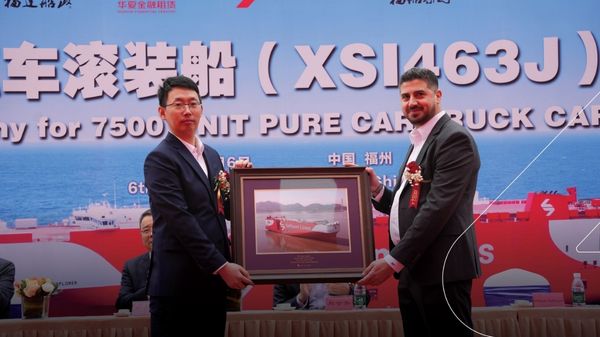
Hapag-Lloyd reports that its average bunker price fell year-on-year (YoY) by $78, or 11.1 percent, to $625 per tonne during the first half (H1) of 2023.
Bunker consumption in H1 for the German shipping line totalled 1.98m tonnes, which was down 6.6% on the 2.12m tonnes recorded a year earlier. The decrease was said to be due to lower transport volumes, the clearing of congestion in front of ports and lower vessel sailing speeds.
As a result, bunker expenses declined by EUR 225.5m, or 16.5 percent, to EUR 1,141.9m in H1 2023, down from EUR 1,367.4m in the prior-year period.
Hapag-Lloyd: Average Bunker Price (US$/mt), 2019-23| Year | H1 | Q2 |
| 2023 | 625.00 | 603.00 |
| 2022 | 703.00 | 793.00 |
| 2021 | 421.00 | 458.00 |
| 2020 | 448.00 | 360.00 |
| 2019 | 429.00 | 434.00 |
| Year | H1 | Q2 |
| 2023 | 1,141.9 | 519.5 |
| 2022 | 1,367.4 | 786.0 |
| 2021 | 725.3 | 403.5 |
| 2020 | 862.9 | 268.6 |
| 2019 | 822.2 | 427.6 |
| Year | H1 | Q2 |
| 2023 | 1.98 | 0.95 |
| 2022 | 2.12 | 1.06 |
| 2021 | 2.11 | 1.06 |
| 2020 | 2.05 | 0.95 |
| 2019 | 2.20 | 1.10 |
Bunker consumption
Bunker consumption per slot (measured by average container slot capacity, annualised) dipped 10% in H1 to 2.18 tonnes. The improvement was due to efficiency measures and lower bunker consumption, Hapag explained.
Bunker consumption per TEU transported also decreased in H1 — by 3% to 0.34 tonnes.
As regards the consumption of low-sulphur bunker (MFO 0.1% and 0.5%, and distillates) and LNG, Hapag said the H1 figure dipped YoY from 88% to 83% due to the fitting of more vessels with scrubbers.
Key financial results
In its overall results, Hapag-Lloyd posted a H1 profit of $3,133m (down 66.9% on the $9,466m result recorded in H1 2022) and a Q2 profit of $1,102 (77% below last year's figure of $4,782m).
EBITDA of $3,775m in H1 represents a 65.5% drop compared to the previous year's $10,942m result. Second-quarter EBITDA decreased YoY by $4,239m, or 75.2 %, to $1,396m.
Revenue in H1 fell 42% YoY from $18,562m to $10,847m, whilst in Q2 the figure dropped 49.8% from $9,606m to $4,819m.
Transport expenses in H1 were 9.3% below the prior-year level, at $6,330m. This was said to be primarily due a lower bunker consumption price of $625 per tonne and lower demurrage and detention expenses.

|
Singapore's first fully electric tug completes commissioning ahead of April deployment
PaxOcean and ABB’s 50-tonne bollard-pull vessel represents an early step in harbour craft electrification. |
|
|
|
||

|
Lloyd's Register report examines hydrogen's potential and challenges for decarbonisation
Classification society highlights fuel's promise alongside safety, infrastructure, and cost barriers limiting maritime adoption. |
|
|
|
||

|
BV Malaysia partners with Straits Bio-LNG on sustainable biomethane certification
MoU aims to establish ISCC EU-certified biomethane production and liquefaction facility in strategic alliance. |
|
|
|
||

|
Molgas becomes non-clearing member at European Energy Exchange
Spanish energy company joins EEX as it expands European operations and strengthens shipper role. |
|
|
|
||

|
Diamandopoulos appointed CEO of Elinoil as Aligizakis becomes chairman
Greek marine lube supplier announces leadership changes following board meeting on 5 January. |
|
|
|
||

|
Bureau Veritas to host webinar on sustainable marine fuel transition challenges
Classification society to address regulatory compliance, market trends, and investment strategies in February online event. |
|
|
|
||

|
Inchcape to provide bunkering services from new Indonesian offices
Port agency establishes presence in key bulk and tanker operation hubs handling 150 calls annually. |
|
|
|
||

|
Chimbusco Pan Nation launches B100 biodiesel supply in Hong Kong
Bunker tanker Guo Si becomes Hong Kong's first Type II certified vessel for pure biodiesel operations. |
|
|
|
||

|
Van Oord completes Dutch beach replenishment using 100% bio-LNG
Dredger Vox Apolonia deposited 1 million cbm of sand at Noord-Beveland beach under Coastline Care programme. |
|
|
|
||

|
Sallaum Lines takes delivery of LNG-fuelled car carrier MV Ocean Explorer
The 200-metre vessel was built by Fujian Mawei Shipbuilding with dual-fuel propulsion systems. |
|
|
|
||
| ExxonMobil starts Hapag ARA biofuel deliveries [News & Insights] |